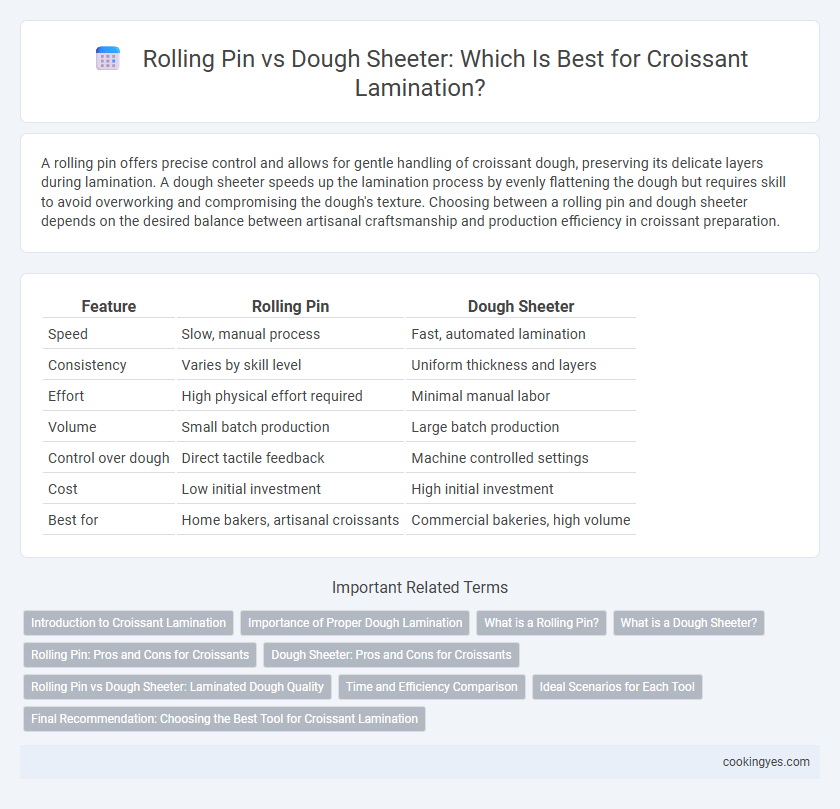A rolling pin offers precise control and allows for gentle handling of croissant dough, preserving its delicate layers during lamination. A dough sheeter speeds up the lamination process by evenly flattening the dough but requires skill to avoid overworking and compromising the dough's texture. Choosing between a rolling pin and dough sheeter depends on the desired balance between artisanal craftsmanship and production efficiency in croissant preparation.
Table of Comparison
| Feature | Rolling Pin | Dough Sheeter |
|---|---|---|
| Speed | Slow, manual process | Fast, automated lamination |
| Consistency | Varies by skill level | Uniform thickness and layers |
| Effort | High physical effort required | Minimal manual labor |
| Volume | Small batch production | Large batch production |
| Control over dough | Direct tactile feedback | Machine controlled settings |
| Cost | Low initial investment | High initial investment |
| Best for | Home bakers, artisanal croissants | Commercial bakeries, high volume |
Introduction to Croissant Lamination
Croissant lamination involves creating thin, even layers of butter and dough to achieve a flaky texture, where consistency and precision are crucial. A rolling pin offers manual control, allowing bakers to feel the dough's texture, but it requires skill and time to maintain uniform thickness. In contrast, a dough sheeter provides faster, consistent lamination by evenly rolling the dough through adjustable rollers, enhancing efficiency in croissant production.
Importance of Proper Dough Lamination
Proper dough lamination is crucial for achieving the flaky, airy texture characteristic of high-quality croissants. A rolling pin allows for precise, tactile control over dough thickness and folding, essential for layering butter evenly, while a dough sheeter offers consistent, uniform layers that can increase efficiency in commercial production. Choosing the right tool depends on balancing the need for delicate craftsmanship with the demands of volume and consistency in lamination.
What is a Rolling Pin?
A rolling pin is a traditional kitchen tool used to manually roll out dough for croissant lamination, providing tactile control over thickness and dough texture. Its cylindrical shape allows even pressure distribution, essential for achieving the delicate layers in croissants. While slower than dough sheeters, rolling pins offer precise handling, making them ideal for small batches and artisanal baking.
What is a Dough Sheeter?
A dough sheeter is a specialized machine designed to roll and laminate dough with consistent thickness, essential for croissant layers. It helps achieve uniformity and precision by evenly pressing dough through adjustable rollers, accelerating the lamination process compared to manual rolling pin methods. Using a dough sheeter enhances dough elasticity and creates distinct, flaky layers necessary for high-quality croissants.
Rolling Pin: Pros and Cons for Croissants
Using a rolling pin for croissant lamination offers precise control over dough thickness, allowing bakers to adjust pressure and achieve even layers essential for flakiness. However, manual rolling can be time-consuming and inconsistent, leading to uneven lamination that affects the croissant's texture and rise. While ideal for small batches and artisanal baking, a rolling pin requires skill and patience compared to the speed and uniformity provided by a dough sheeter.
Dough Sheeter: Pros and Cons for Croissants
A dough sheeter offers consistent and even lamination for croissants, ensuring uniform thickness and layers, which enhances the final flaky texture. It significantly reduces labor time compared to a rolling pin, making it ideal for commercial bakeries or high-volume production. However, dough sheeters can be expensive and may require maintenance, and they risk overworking the dough if not carefully operated, potentially compromising croissant quality.
Rolling Pin vs Dough Sheeter: Laminated Dough Quality
Laminated dough quality significantly differs when using a rolling pin versus a dough sheeter for croissant preparation. A dough sheeter provides consistent thickness and even layering, enhancing the croissant's flakiness and rise, while manual rolling with a pin can lead to uneven layers and variable texture. Professional bakeries prefer dough sheeters for precise lamination, ensuring uniform gluten development and optimal butter incorporation.
Time and Efficiency Comparison
A dough sheeter significantly reduces lamination time by evenly rolling dough layers within minutes, boosting overall bakery efficiency compared to manual rolling pins. Rolling pins require considerable skill and time to achieve consistent thickness and delicate layers essential for croissant flakiness. Automated sheeters streamline production, enabling higher output levels while maintaining uniform dough texture, crucial for premium croissant quality.
Ideal Scenarios for Each Tool
A rolling pin excels in small-scale croissant lamination, offering precise control over dough thickness and ideal for artisanal bakeries or home bakers aiming for delicate, flaky layers. Dough sheeters suit high-volume production environments such as commercial bakeries, providing uniform lamination, increased efficiency, and consistent pastry quality across large batches. Selecting between tools depends on production scale, desired dough texture, and workflow speed to optimize croissant lamination results.
Final Recommendation: Choosing the Best Tool for Croissant Lamination
For croissant lamination, a dough sheeter provides consistent and even dough thickness, which is critical for achieving uniform layers and optimal flakiness. A rolling pin offers greater control and traditional craftsmanship but requires skill to maintain precision and prevent uneven lamination. Professional bakers often prefer dough sheeters for efficiency and reliability, while artisanal bakers might choose rolling pins to preserve hands-on technique and texture nuances.
Rolling pin vs dough sheeter for croissant lamination Infographic

 cookingyes.com
cookingyes.com